Two-Stage Optimal Configuration Strategy of Distributed Synchronous Condensers at the Sending End of Large-Scale Wind Power Generation Bases
Abstract
1. Introduction
1.1. Research Background
1.2. Literature Survey
1.3. Research Focus and Organization
- (1)
- Insufficient depth in the analysis of the DC reactive power demand and the reactive power output of the SC during various transient stages post-fault, coupled with a lack of detailed examination of the coupling relationship across different time scales. This paper introduces a reactive power output model for distributed regulators from both transient and sub-transient perspectives and quantitatively assesses the influence of distributed SC integration on short-circuit ratio (SCR) enhancement and transient overvoltage suppression capabilities.
- (2)
- Current research has overlooked the impact of optimal distributed SC allocation on inertia enhancement and dynamic frequency support. This paper examines the effect of distributed SC integration on the dynamic inertia response of new energy bases at the sending end. The dynamic frequency support characteristics of large energy bases are analyzed based on the nodal inertia model, and a critical inertia constraint is proposed that is grounded in frequency stability considerations.
- (3)
- Existing optimization objectives are predominantly analyzed from a single perspective, either focusing on SCR enhancement or transient overvoltage suppression, which fails to address the comprehensive requirements for MRSCR and transient voltage stability. In this paper, a two-stage optimal configuration strategy for distributed SCs at the transmission end is proposed, considering dynamic frequency support and transient voltage stability. In the first stage, the optimal SC configuration aims to maximize system inertia improvement per unit investment to meet dynamic frequency support requirements. The second stage adjusts the configuration results from the first stage by incorporating constraints for enhancing the MRSCR and suppressing transient overvoltage.
2. Dynamic Frequency Support Capability Analysis for Considering SC Accessing of Large-Scale Wind Power Generation Bases Based on Node Inertia Modeling
2.1. Dynamic Inertial Response Model for Considering SC Accessing of Large-Scale Wind Power Generation Bases
2.2. Dynamic Frequency Support Analysis of Large Energy Bases Based on Nodal Inertia Modeling
2.3. Inertia Modeling of Large Energy Bases Based on Frequency Stability Constraints
2.3.1. Critical Inertia Modeling Based on Frequency Maximum Deviation Δfdis-max
2.3.2. Critical Inertia Modeling Based on the Maximum Change Rate of Frequency RoCoFdis-max
3. Short-Circuit Ratio Enhancement and Transient Overvoltage Suppression Analysis for Considering SC Accessing of Large-Scale Wind Power Generation Bases
3.1. Transient Overvoltage Suppression Analysis for Considering SC Accessing of Renewable Energy Convergence Areas
3.1.1. Transient Overvoltage Conduction Mechanism for Considering SC Accessing of Renewable Energy Convergence Areas
3.1.2. Transient Voltage Stabilization Mechanism of Distributed SC Accessing in Multiple Time Scales
3.2. MRSCR Index Impact Analysis for Considering SC Accessing of Renewable Energy Convergence Areas
4. Materials and Methods: Two-Stage Optimal Configuration Strategy of Distributed SCs at the Sending End of Large-Scale Wind Power Generation Bases Considering the Profit Balance of Multiple Actors under Joint Market Trading
4.1. Stage 1: Distributed SC Configuration Model Considering Economic Cost and Dynamic Frequency Support
- (1)
- System tidal current constraintwhere Ui and Uj represent the voltages at nodes i and j. Pi and Qj represent the active and reactive power at node i. Gij and Bij represent the node conductance matrix conductivity and conductance parameters. θij represents the phase angle difference between nodes i and j. n represents the total number of system nodes.
- (2)
- Number of nodes accessed by SC constraintwhere κp,max represents the upper number limit of accessing to the distributed SCs at node p, which is restricted by geographic location or technical conditions.
- (3)
- Distributed SC initial investment cost constraintwhere Cinv,max represents the upper limit of the distributed SC initial investment cost.
- (4)
- Frequency stability constraint based on node inertia modeling
4.2. Stage 2: Installation Location and Capacity Modification Model for Distributed SC Considering Economic Cost and Dynamic Frequency Support
- (1)
- Transient voltage stability constraints
- (2)
- Minimum MRSCR limit constraints at the sending end gridwhere MRSCR represents the MRSCR of the i-th RE station. MRSCRi,min and MRSCRmin represent the minimum limit MRSCR value of the i-th RE station and the minimum limit MRSCR value at the sending end grid after Stage 2 correction.
- (3)
- MRSCR equalization constraint at the sending end grid
4.3. Solving Steps of the Two-Stage Optimal Configuration Strategy for Distributed SCs
- (1)
- Set the Matlab optimization initial parameters to set the initial values of the SC’s mounting position and capacity.
- (2)
- Stage 1 frequency stability optimization: optimize with the objective of maximizing the system inertia per unit of investment, derive the Stage 1 SC installation position and capacity results, and determine the minimum inertia to maintain frequency stability.
- (3)
- Stage 2 MRSCR calibration: check whether the Stage 1 optimization results satisfy the MRSCR and balancing constraints. If not, install additional SCs at the lowest MRSCR locations until the MRSCR machine balancing constraints are satisfied.
- (4)
- Stage 2 transient voltage calibration: Check the current configuration results against the transient voltage stability constraints. If the constraints are not met, make additional adjustments to the position and capacity of the SC until the constraints are met.
- (5)
- Economy check: If more SCs are installed in the second stage, the current configuration may be over-invested. The results in (4) are checked for economy, and if they are not satisfied, the SC configuration is gradually reduced until the constraints cannot be satisfied. The optimal configuration result will be chosen based on the maximum value of system inertia enhancement per unit of investment among all scenarios that satisfy each constraint.
- (6)
- Output the result of two-stage optimal configuration of distributed SC considering dynamic frequency support and transient voltage stability.
5. Case Study
5.1. Data Collection and Parameter Selection
5.2. Stage 1: Distributed SC Configuration Results Considering Economic Cost and Dynamic Frequency Support
5.3. Stage 2: Installation Location and Capacity Modification Results for Distributed SC Considering Economic Cost and Dynamic Frequency Support
5.4. Sensitivity Analysis of SC Capacity Configurations to DC Reactive Power Demand and Transient Voltage
6. Discussion and Future Work
6.1. Discussion
- (1)
- Nodal inertia can reflect the distribution characteristics of system inertia and can be utilized to identify weak points in dynamic frequency support. By considering the critical inertia for frequency stability, distributed SCs can be installed at the bus with the lowest nodal inertia at the convergence station, effectively enhancing dynamic frequency support. Therefore, this strategy aims to achieve the maximum node inertia enhancement rate (0.347) with minimal economic cost (0.751 billion yuan), balancing economic benefits and frequency stability.
- (2)
- The MRSCR analysis of the RE convergence area demonstrates the enhancement of MRSCR for wind farms. This strategy elucidates the impact mechanism of the SC transient reactive power characteristics during the sub-transient and transient processes in the sending-end grid. A specific case study confirms that the installation of distributed regulating equipment in the sending-end grid successfully mitigates transient overvoltage at the machine end, significantly enhancing transient voltage support. Upon accessing two SCs at node 45, strong excitation reaches 3.9 times the reactive power output to fulfill the converter’s reactive power consumption (3.7 times the rated capacity).
- (3)
- By considering the location and capacity of the SCs as variables, a two-stage optimal configuration strategy of distributed SCs is proposed at the sending end of large-scale wind power generation bases, considering dynamic frequency support and transient voltage stabilization. The results indicate that the optimized configuration, while meeting MRSCR, equilibrium, and transient voltage stability constraints, maximizes system inertia enhancement per unit of investment and avoids over-investment. This optimal configuration model addresses the improvement of dynamic frequency response, filling a current gap in end-of-send distributed regulator configurations that do not consider dynamic frequency support enhancements.
6.2. Limitations and Future Work
- (1)
- (2)
- The scope of the research in this thesis can be further expanded with more detailed data support. The model can be simulated on a monthly, yearly, or multi-year basis to investigate the optimal operational modes for large-scale energy base reactive power compensation configurations over long-term periods.
- (3)
- Since distributed capacitors can also improve the transient voltage characteristics, we will further study the synergistic planning of distributed capacitors with distributed SCs. In addition, we will study the relationship between the frequency variation in the center of inertia and the inertia of the system, and the disturbed power under various faults using the neural network model [28].
Author Contributions
Funding
Data Availability Statement
Conflicts of Interest
Nomenclature
| Heq | the equivalent inertia of the system | the reactive power response variation in the distributed SCs | |
| Ji and wi | the rotational inertia and rated speed of the i-th synchronous generator | ΔEf | the hypothetical no-load potential change |
| Si and Sj | the rated capacity of the synchronous generator and the RE unit | T | the control time constant of the excitation system |
| Heq′ | the equivalent inertia after the access of distributed SCs | Ka | the strong excitation multiplier of the excitation system |
| K | the number of distributed SCs connected to the system | URi and IRi | the injected system current and bus voltage vectors for the transient process of RE stations |
| Jk, wk and Sk | the rotational inertia, rated speed and rated capacity of the k-th SC | Zij | the node impedance matrix |
| D | the system damping coefficient | UMi | the grid-accessed rated voltage of RE stations |
| ΔPdis and ΔPm | the instantaneous disturbance power and the mechanical power added by the synchronous generator | Z′ij | the mutual impedance in the node impedance matrix after SC accessing |
| fcen | the center of inertia frequency | ΔHp | the inertia change in node p before and after optimization in the first stage |
| ΔPdis-p | the system disturbance power | Cta,p | the cost of purchasing and installing a single SC accessed by node p |
| Hp | the inertia of any node p | Cm | the unit-capacity SC cost of operation and maintenance |
| fp | the frequency of node p | Qp | a single SC capacity accessed by node p |
| J | the set of synchronous generator and SC access nodes | P | the total number of nodes |
| Uj and Uk | the pre-disturbance voltage amplitudes | κp | the number of SCs accessed by node p |
| δjk0 | the pre-disturbance phase angle difference between nodes j and k before the disturbance | Ui and Uj | the voltages at nodes i and j. |
| Bjk | the pre-disturbance electricana of node j and fault node k | Pi and Qi | the active and reactive power at node i |
| UJ and UP | the voltage vectors of the synchronous generator or SC accessing node j and p | Gij and Bij | the node conductance matrix conductivity and conductance parameters |
| Ys | the node broadening conductance matrix | θij | the phase angle difference between nodes i and j |
| YJJ, YPP, YJP and YPJ | the self conductance and mutual conductance of the node broadening conductance matrix | κp,max | the upper number limit of accessing to the distributed SCs at node p |
| δj and δp | the corresponding phase angles of nodes j and p | Cinv,max | the upper limit of the distributed SC initial investment cost |
| Δfdis-max | the maximum frequency deviation | Q1p and Q2p | the distributed SC’s capacity at node p before and after the second-stage correction |
| RoCoFdis-max | the maximum change rate of frequency | MRSCR2 and MRSCR1 | the index MRSCR of large energy bases before and after the second-stage correction |
| fs | the reference frequency | v | the node that does not meet the transient voltage stability constraints |
| Δfmax | the maximum frequency deviation required by the national standard | V | the total number of nodes that need adjustments |
| Sb | the system capacity | Q1v and Q2v | the SC’s capacity at node v before and after the second-stage correction |
| the critical inertia | |ΔU1| and |ΔU2| | the voltage difference from the voltage stabilization limit in the worst short-circuit case before and after the second-stage correction | |
| RoCoFmax | the maximum change rate of frequency required by the national standard | Ui(t0+x) | the node i voltage after x seconds of the fault |
| UD | the bus voltage at converter station D | Uis0 | the steady-state voltage of node i before the fault |
| UM and QM | the steady-state converging station bus voltage and reactive power output | MRSCRi,min and MRSCRmin | the minimum limit MRSCR value of the i-th RE station and the minimum limit value MRSCR at the sending end grid after the Stage 2 correction |
| Δid | the d-axis current variation | λMRSCR | the upper limit of MRSCR equalization |
| the d-axis sub-transient reactance and short-circuit time constant | MRSCRav | the average MRSCR value at RE stations | |
| the d-axis transient reactance and short-circuit time constant | Ta | the time constant of the stator non-periodic component | |
| ΔUs | the drop value of the bus voltage |
References
- Chen, G.; Dong, Y.; Liang, Z. Analysis and reflection on high-quality development of new energy with Chinese characteristics in energy transition. Proc. CSEE 2020, 40, 5493–5505. (In Chinese) [Google Scholar]
- Klyuev, R.; Bosikov, I.; Gavrina, O. Use of Wind Power Stations for Energy Supply to Consumers in Mountain Territories. In Proceedings of the 2019 International Ural Conference on Electrical Power Engineering (Uralcon), Chelyabinsk, Russia, 3–1 October 2019; pp. 116–121. [Google Scholar]
- Cheng, X.; Yan, B.; Zhou, X.; Yang, Q.; Huang, G.; Su, Y.; Yang, W.; Jiang, Y. Wind resource assessment at mountainous wind farm: Fusion of RANS and vertical multi-point on-site measured wind field data. Appl. Energy 2024, 363, 123116. [Google Scholar] [CrossRef]
- Shen, G.; Xin, H.; Liu, X.; Tu, J.; Wang, K.; Wang, N. Analysis on synchronization instability mechanism and influence factors for condenser in large-scale renewable energy base. Autom. Electr. Power Syst. 2022, 46, 100–108. (In Chinese) [Google Scholar]
- Zhang, X.; Liu, F.; Wang, S. Measures to enhance new energy consumption in extra-high voltage direct current feeder grids. Proc. CSU-EPSA 2022, 34, 135–141. [Google Scholar]
- Jin, Y.; Yu, Z.; Li, M.; Jiang, W. Comparison of new generation regulator and power electronic reactive power compensation device applied in extra-high voltage AC and DC grids. Power Grid Technol. 2018, 42, 2095–2102. [Google Scholar]
- Cao, W.; Zhang, T.; Fu, Y.; Yao, Y.B.; Chen, S.Y. Research and application of synchronous regulator to enhance power system inertia and improve frequency response. Power Syst. Autom. 2020, 44, 1–10. [Google Scholar]
- Mansour, M.Z.; Me, S.P.; Hadavi, S.; Badrzadeh, B.; Karimi, A.; Bahrani, B. Nonlinear transient stability analysis of phased-locked loop-based grid-following voltage-source converters using Lyapunov’s direct method. IEEE J. Emerg. Sel. Top. Power Electron. 2022, 10, 2699–2709. [Google Scholar] [CrossRef]
- He, X.; Geng, H. Transient stability of power systems integrated with inverter-based generation. IEEE Trans. Power Syst. 2021, 36, 553–556. [Google Scholar] [CrossRef]
- Li, W.; Qian, Z.; Wang, Q.; Wang, Y.; Liu, F.; Zhu, L.; Cheng, S. Transient voltage control of sending-end wind farm using asynchronous condenser under commutation failure of HVDC transmission system. IEEE Access 2021, 9, 54900–54911. [Google Scholar] [CrossRef]
- Suo, Z.; Liu, J.; Jiang, W.; Li, Z.; Yang, L. Research on the configuration of regulator for large-scale new energy DC transmission system. Electr. Power Autom. Equip. 2019, 39, 124–129. [Google Scholar]
- Chang, H.; Huo, C.; Liu, F.; Liu, F.; Ke, X.; Hou, Y.; Niu, S.; Wang, C. Research on optimal configuration of regulating camera for improving transient voltage stability level of weak feeder grid. Power Syst. Prot. Control 2019, 47, 90–95. [Google Scholar]
- Yang, J.; Shi, Z.; He, C.; Li, X.; Liang, Y. Optimal configuration strategy of condenser for improving short-term voltage safety in a sending-end power grid with a high renewable penetration level. J. Shandong Univ. 2024, 54, 174–182. [Google Scholar]
- Wang, Z.; Liu, M.; Li, H.; Qin, J.; Guo, J.; Bai, K. Optimal allocation method of regulating camera to enhance new energy cluster delivery capacity of weak grid. Electr. Power Autom. Equip. 2024, 1–10. [Google Scholar] [CrossRef]
- Wang, Q.; Li, T.; Tang, X.; Liu, F.; Lei, J.; Yuan, C. Method of site selection for synchronous condenser responding to commutation failures of multi-infeed DC system. Autom. Electr. Power Syst. 2019, 43, 222–227. (In Chinese) [Google Scholar]
- Zhou, Y.; Sun, H.; Xu, S.; Wang, X.; Zhao, B.; Zhu, Y. Synchronous condenser optimized configuration scheme for power grid voltage strength improvement. Power Syst. Technol. 2022, 46, 3848–3856. (In Chinese) [Google Scholar]
- Guo, Q.; Li, Z. A review on the development of synchronous regulator. Proc. CSEE 2023, 43, 6050–6064. [Google Scholar]
- Gao, H.; Yuan, H.; Xin, H.; Huang, L.; Feng, C. Nodal frequency performance of power networks. In Proceedings of the IEEE 8th International Conference on Advanced Power System Automation and Protection, Xi’an, China, 21–24 October 2019; pp. 1838–1842. [Google Scholar]
- Zhang, Z.; Zhou, M.; Wu, Z.; Liu, J.; Liu, S.; Guo, Z. An energy storage siting and capacity planning method considering dynamic frequency support. Proc. CSEE 2023, 43, 2708–2721. [Google Scholar]
- Liu, F.; Xu, G.; Liu, J.; Wang, C.; Bi, T.; Guo, X. Characteristics of power system inertia distribution considering grid structure and parameters. Autom. Electr. Power Syst. 2021, 45, 60–67. [Google Scholar]
- Wang, B.; Sun, H.; Li, W.; Yan, J.; Yu, Z.; Yang, C. Minimum inertia assessment of power systems considering dynamic frequency constraints. Proc. CSEE 2022, 42, 114–127. [Google Scholar]
- Li, S.; Tian, B.; Li, H.; Luo, Y.; Huang, S.; Xu, S. A time-phased method for limiting wind power output based on frequency security constraint and critical inertia calculation. Power Syst. Prot. Control 2022, 50, 60–71. [Google Scholar]
- Zheng, C.; Sun, H.; Yang, D. Transient voltage instability criterion and control based on wide-area branch response. Proc. CSEE 2023, 43, 9470–9481. [Google Scholar]
- Zhang, Y.; Xu, Y.; Zhang, R.; Dong, Z.Y. A missing-data tolerant method for data-driven short-term voltage stability assessment of power systems. IEEE Trans. Smart Grid 2019, 10, 5663–5674. [Google Scholar] [CrossRef]
- Xiao, H.; Sun, K.; Pan, J.; Li, Y.; Liu, Y. Review of hybrid HVDC systems combining line communicated converter and voltage source converter. Int. J. Electr. Power Energy Syst. 2021, 129, 106713. [Google Scholar] [CrossRef]
- Sun, H.; Xu, S.; Xu, T.; Guo, Q.; He, J.; Zhao, B.; Yu, L.; Zhang, Y.; Li, W.; Zhou, Y.; et al. Definition and index of short circuit ratio for multiple renewable energy stations. Proc. CSEE 2021, 41, 497–505. (In Chinese) [Google Scholar]
- Huang, W.; Zhang, B.; Ge, L.; He, J.; Liao, W.; Ma, P. Day-ahead optimal scheduling strategy for electrolytic water to hydrogen production in zero-carbon parks type microgrid for optimal utilization of electrolyzer. Energy Storage 2023, 68, 107653. [Google Scholar] [CrossRef]
- Ahmad, M.S.; Ali, M.S.; Abd, R.N. Hydrogen energy vision 2060: Hydrogen as energy carrier in Malaysian primary energy mix—Developing P2G case. Energy Strategy Rev. 2023, 35, 100632. [Google Scholar] [CrossRef]
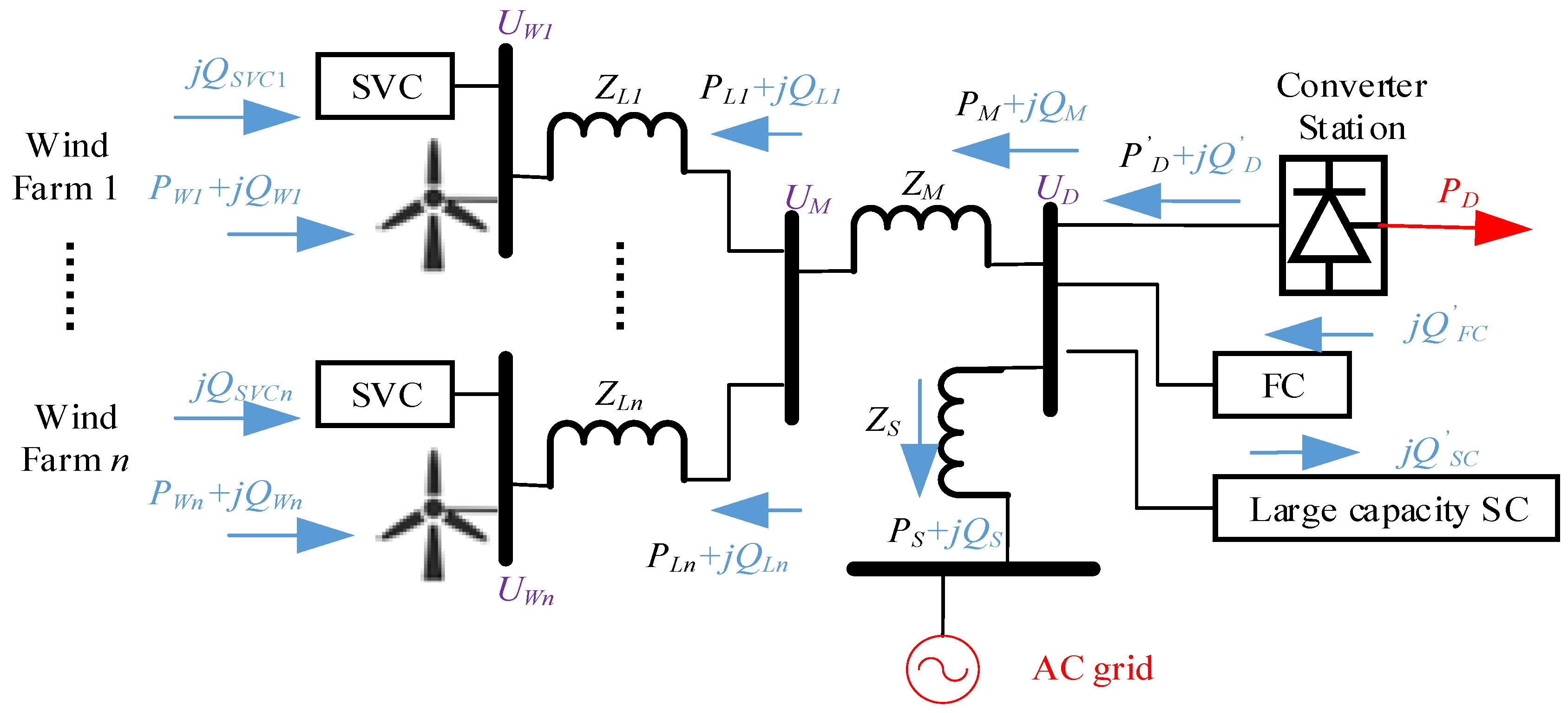
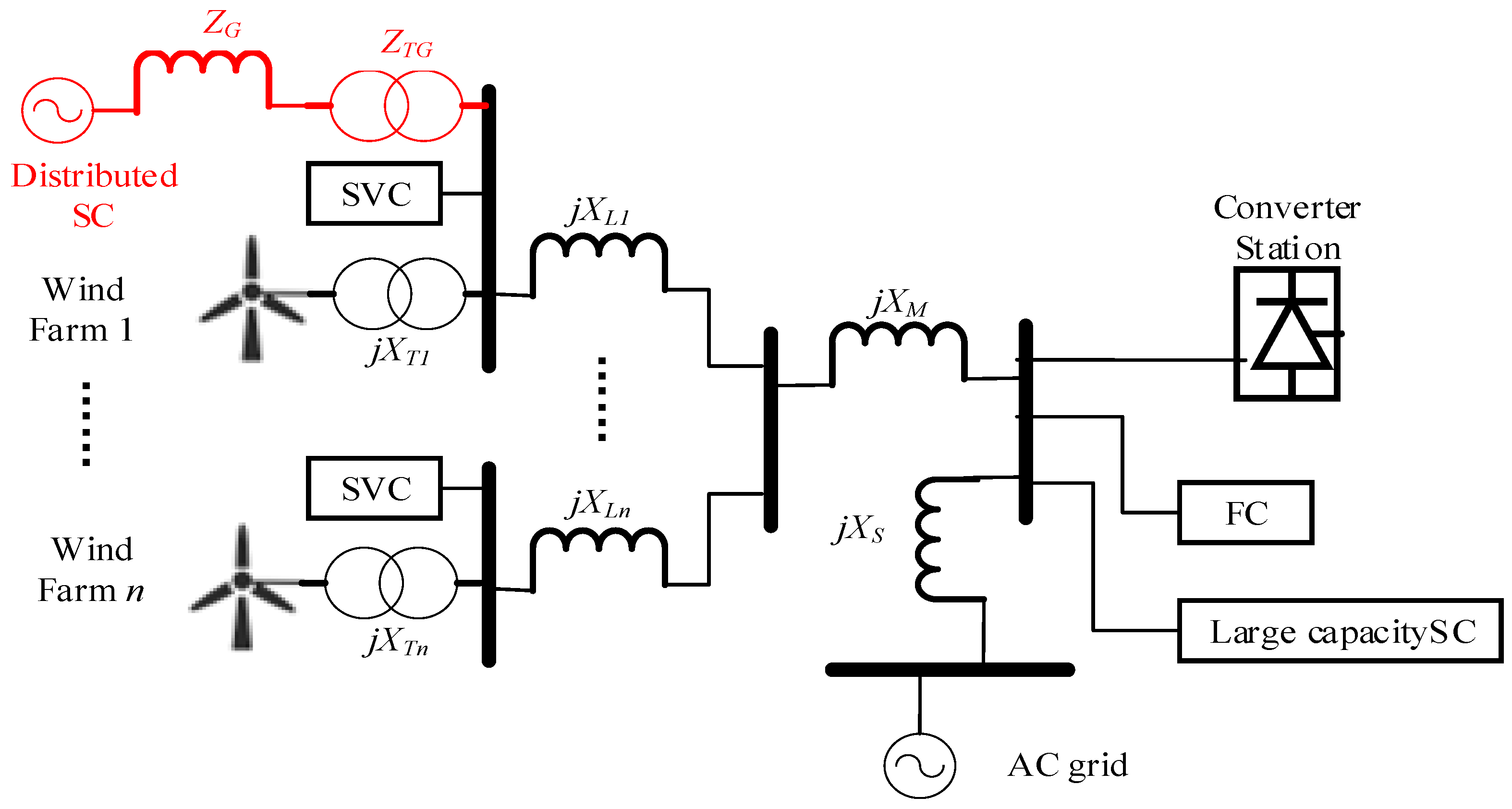
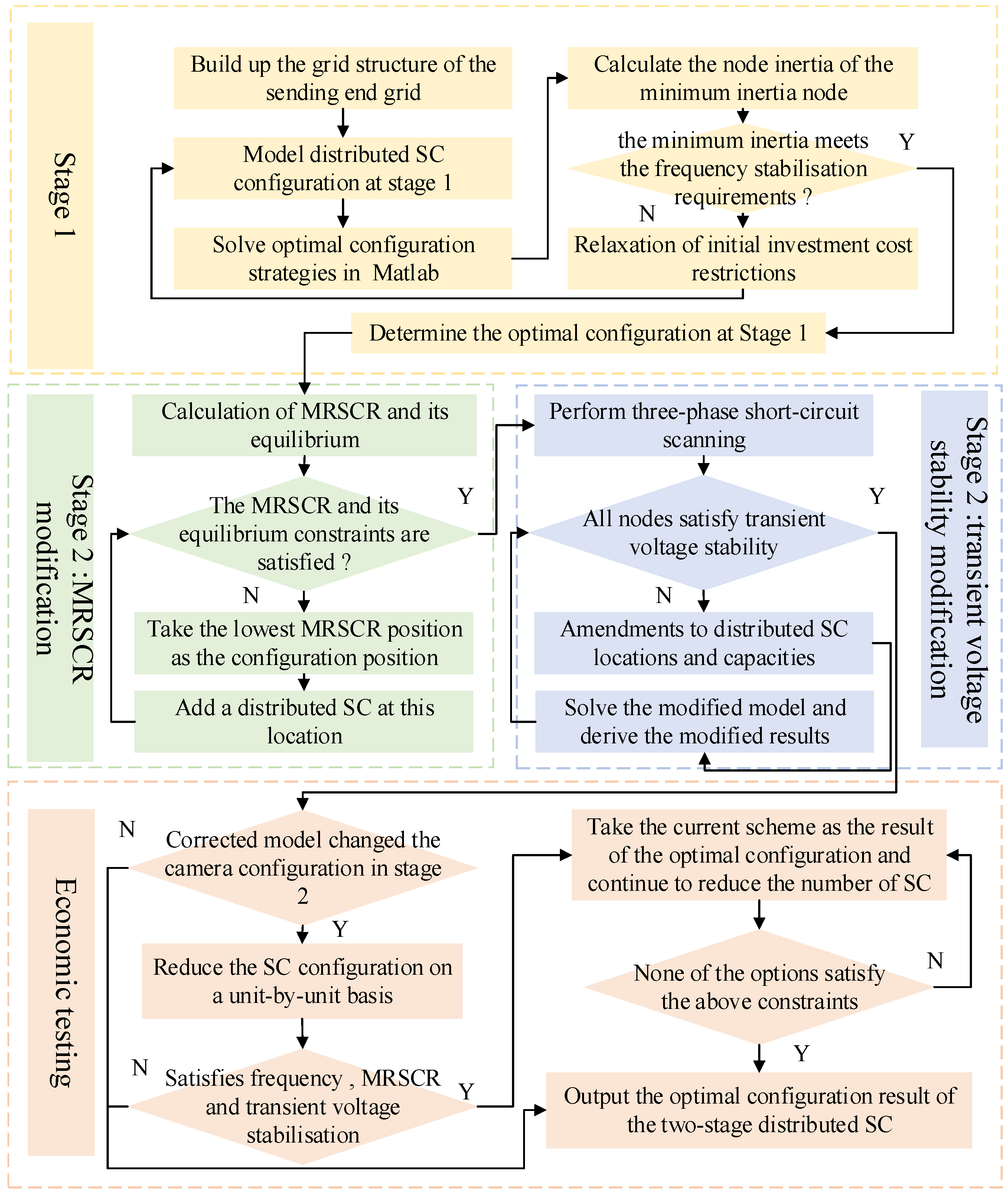
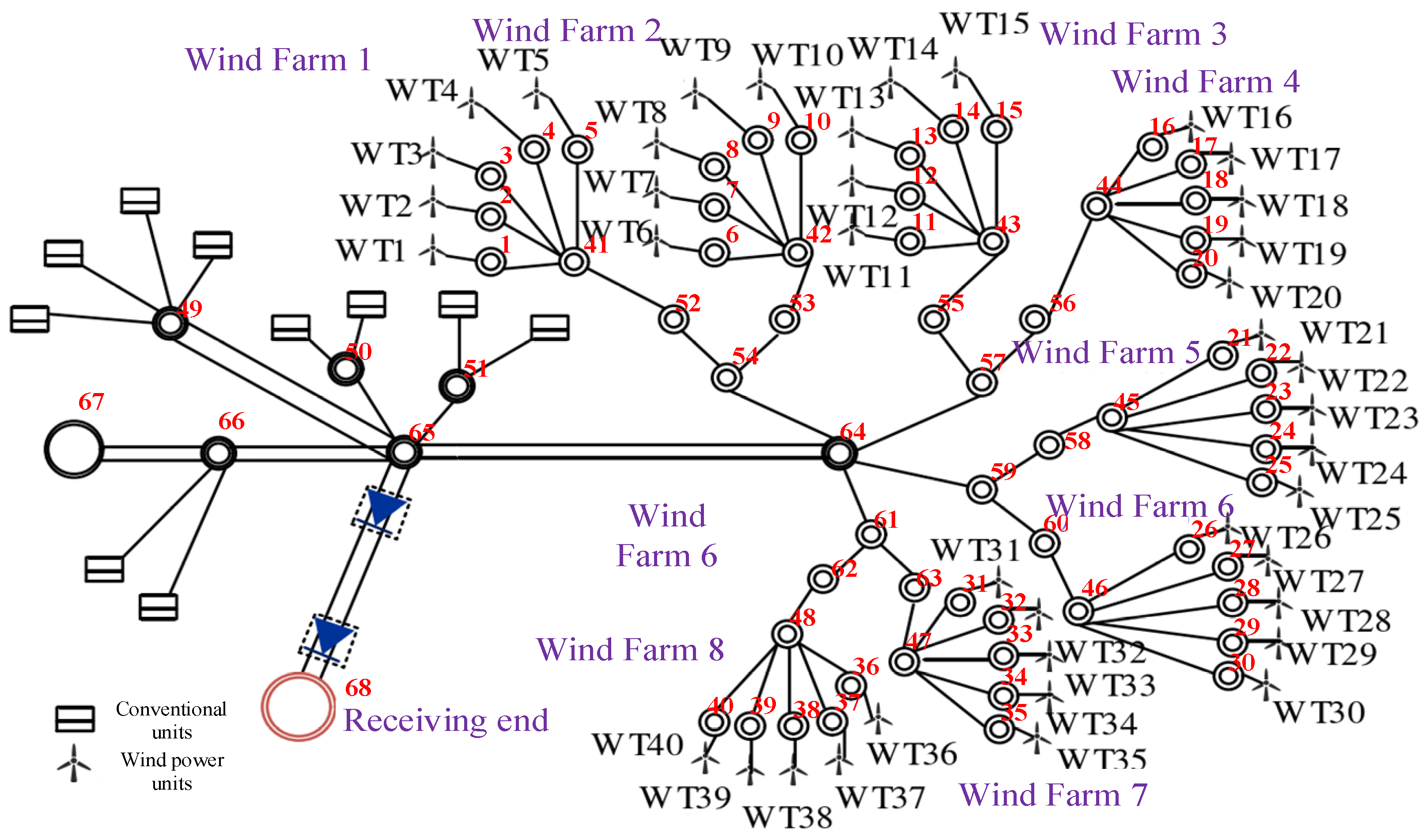
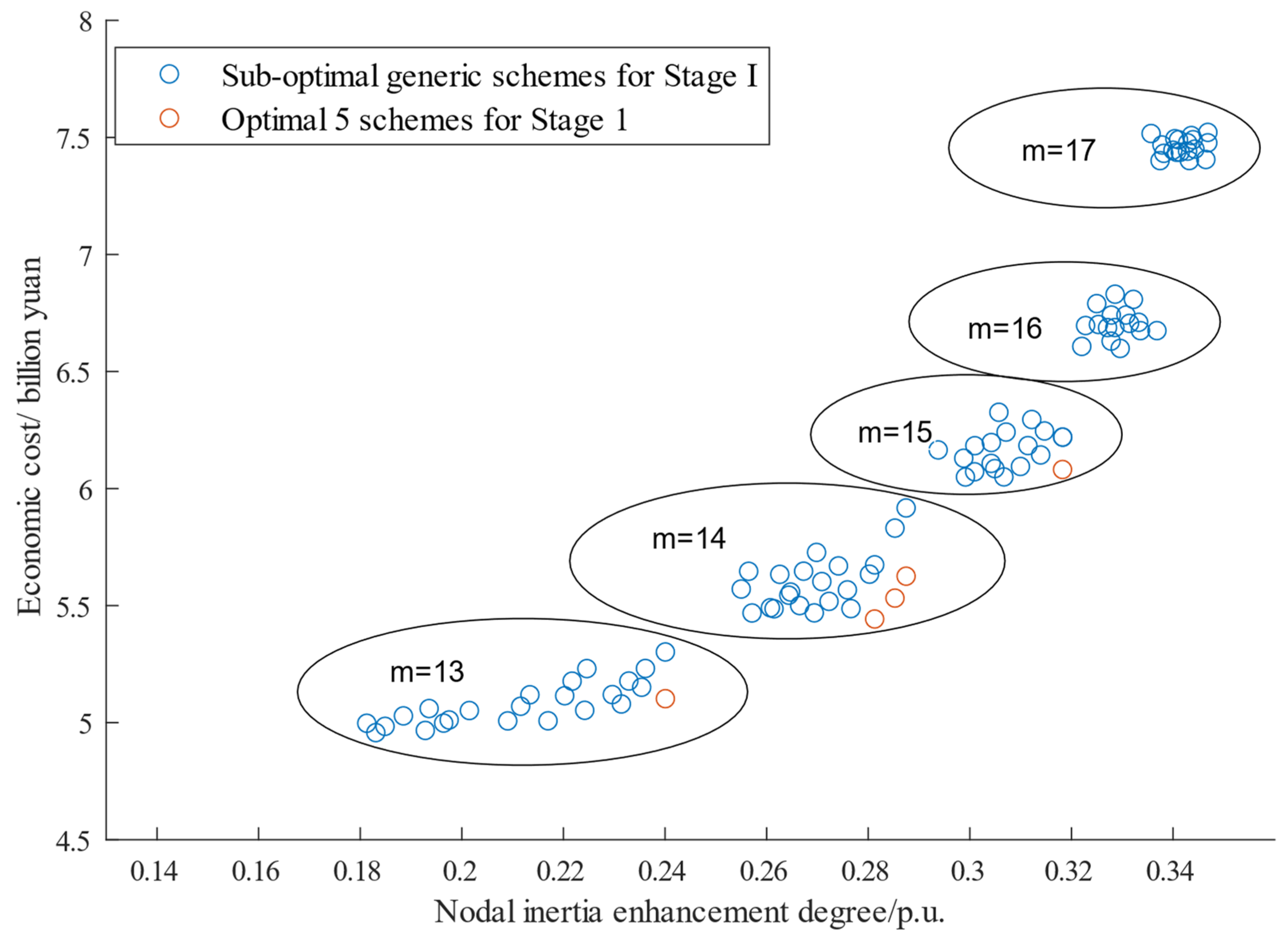
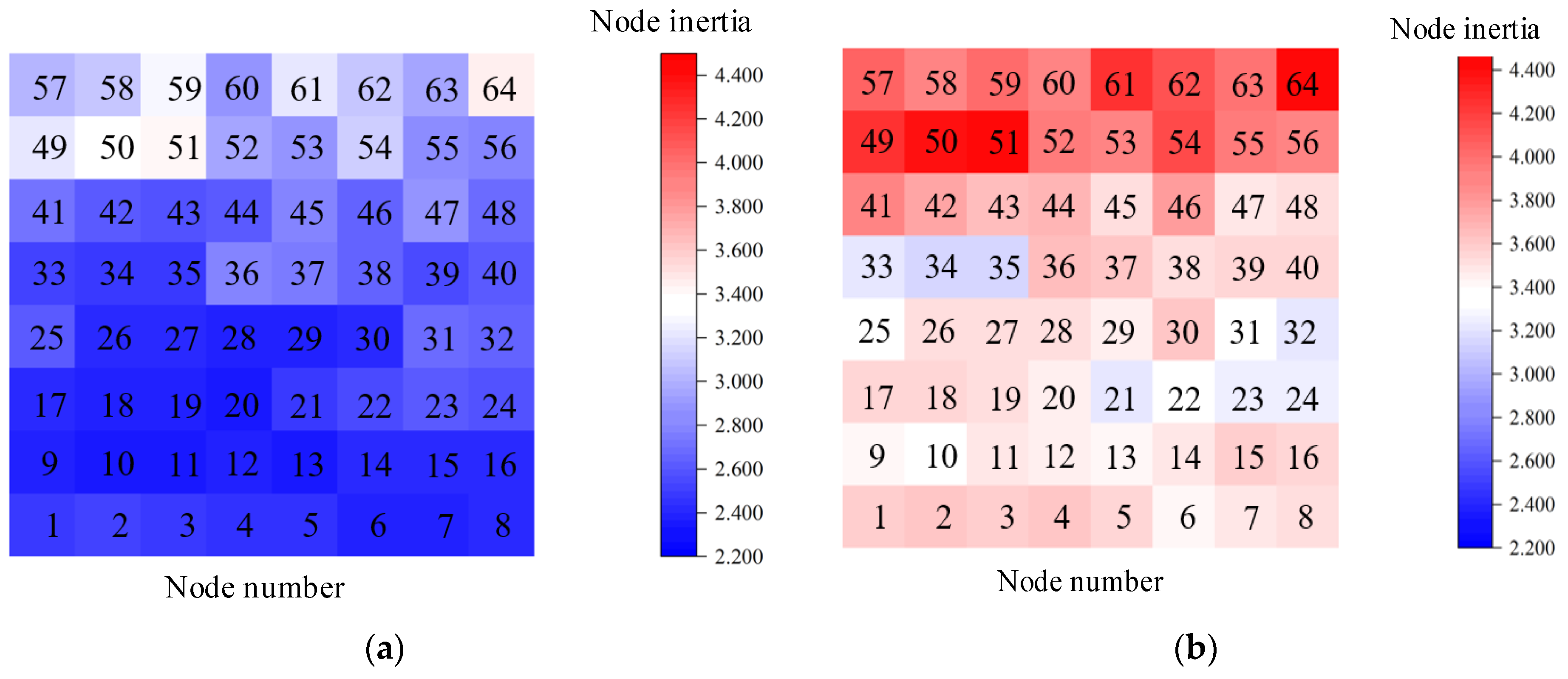


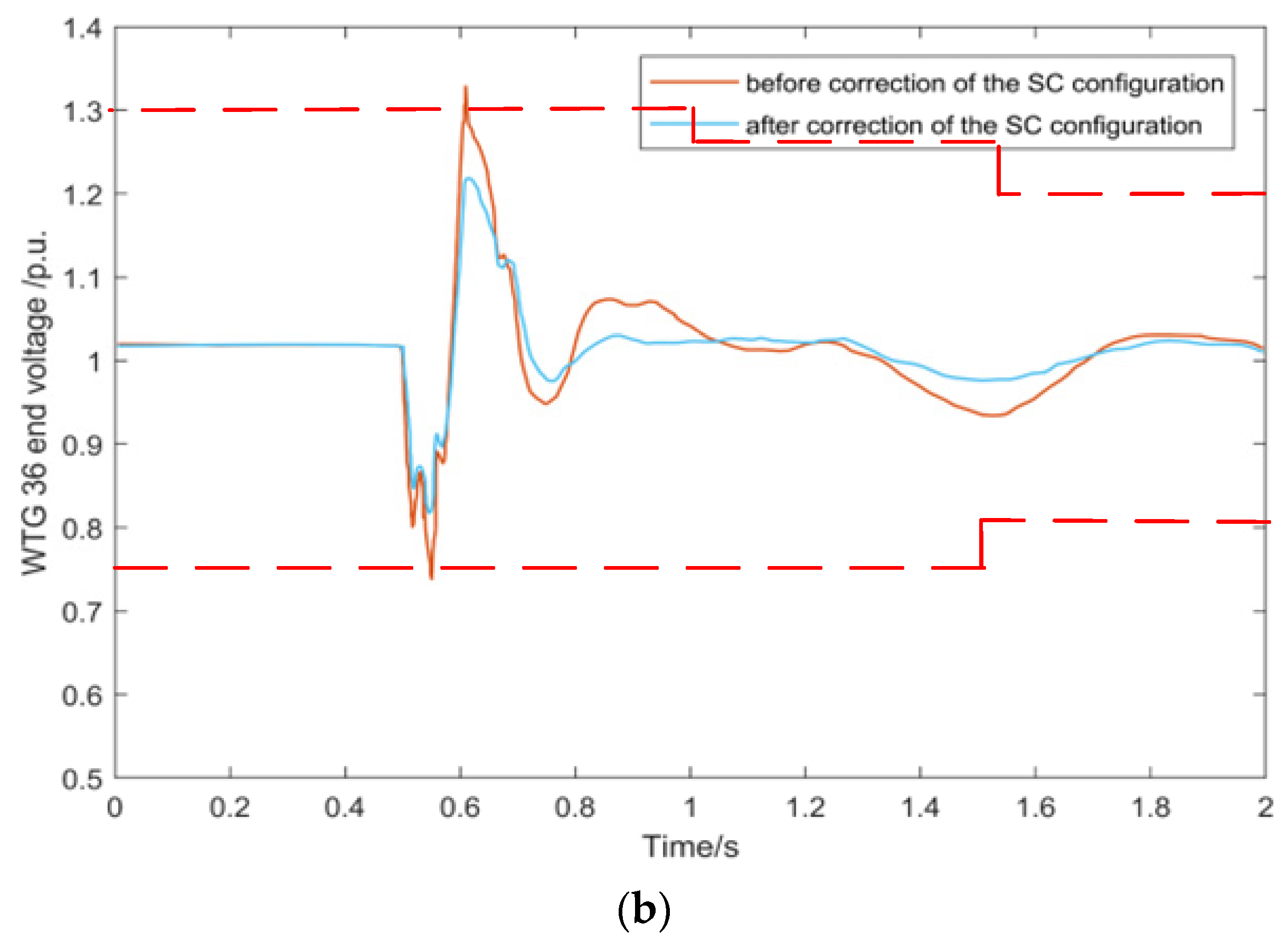
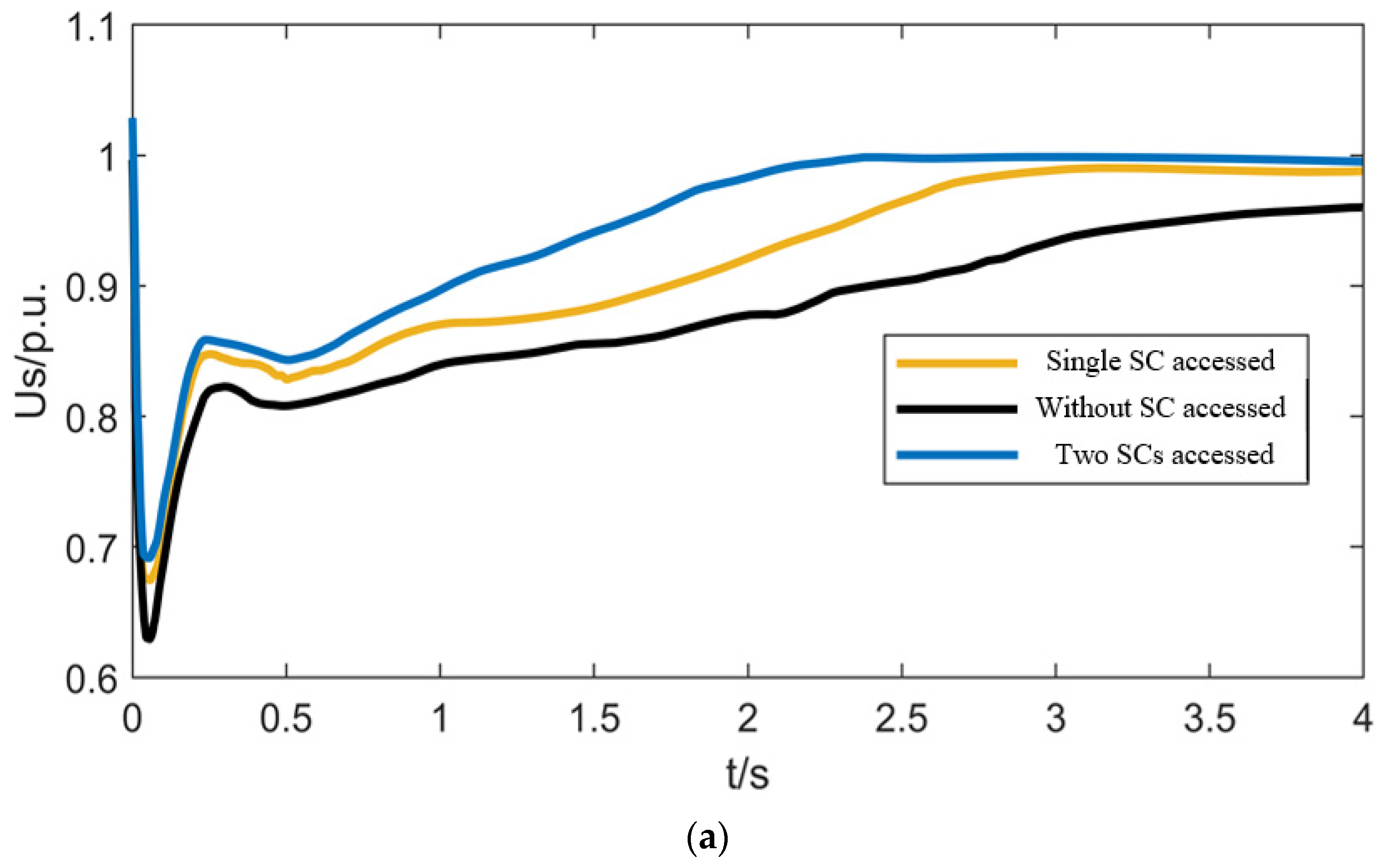
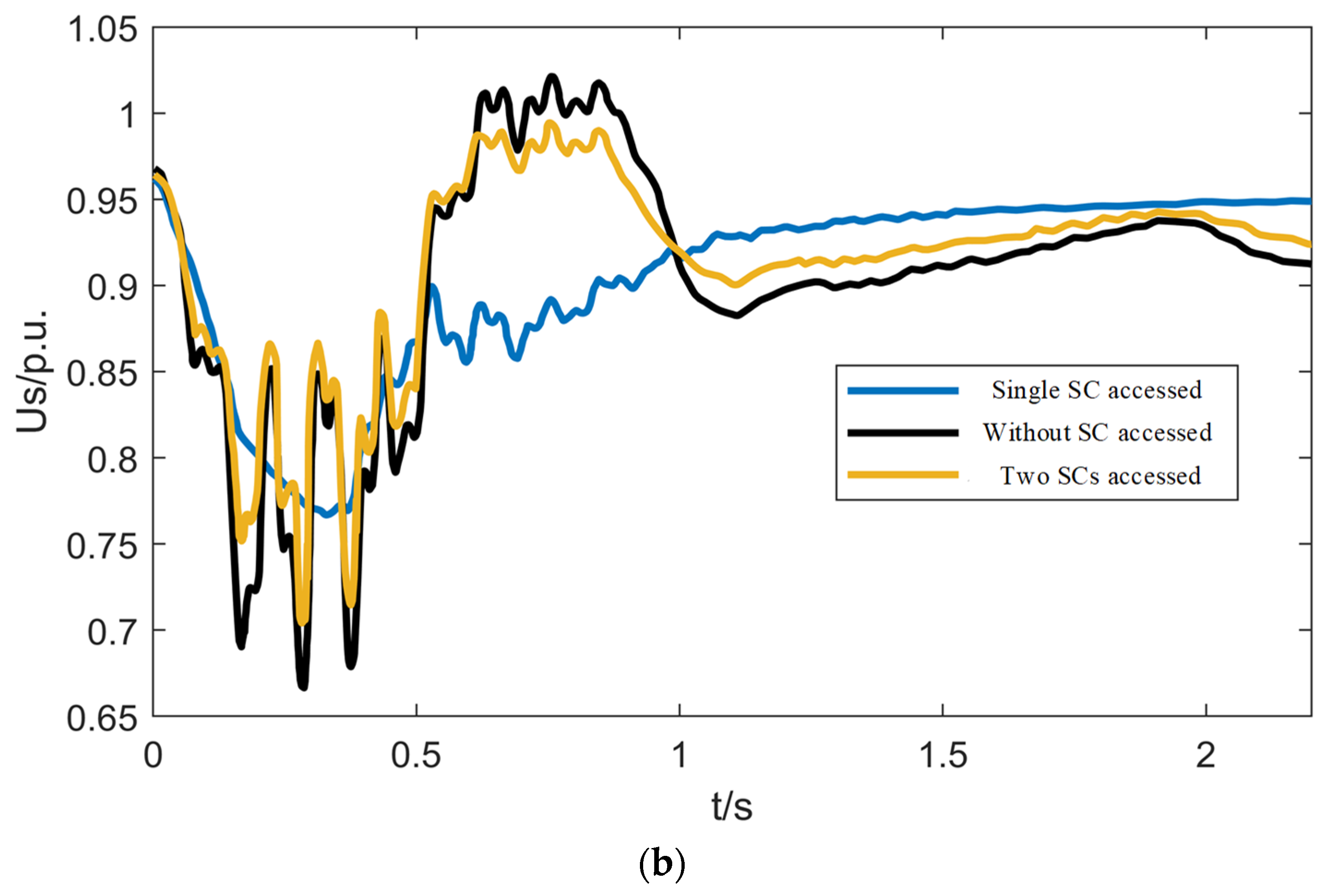

| Parameter | Value | Parameter | Value |
|---|---|---|---|
| 10.9 p.u. | Transient reactance X’d | 16.1 p.u. | |
| 0.06 s | Transient time constant T’d | 7.47 s | |
| Excitation system strong excitation multiplier | 2.41 | Stator non-periodic component time constant Ta | 21.96 s |
| Parameter | Value | Parameter | Value |
|---|---|---|---|
| the unit-capacity SC cost of operation and maintenance Cm | 0.2 million yuan | the upper limit of the distributed SC initial investment cost Cinv,max | 0.8 billion yuan |
| the cost of purchasing and installing a single SC Cta,p | 0.031 billion yuan | the maximum frequency deviation Δfdis-max | 0.23 Hz |
| 2.55 | the maximum change rate of frequency required by the national standard RoCoFmax | 3 Hz/s | |
| the upper limit of MRSCR equalization λMRSCR | 1.5 | the reference frequency fs | 50 Hz |
| the upper number limit of accessing to the distributed SCs κp,max | 4 |
| Number | SC Access Location and Number | Total Accessed Number | Total Capacity Accessed (MVar) | Total Economic Cost (Billion Yuan) | Node Inertia Enhancement Degree | Objective Function Value F |
|---|---|---|---|---|---|---|
| Scheme 1 | 41(1),42(2),43(2),44(2),45(2),46(2),47(1),48(1) | 13 | 650 | 0.528 | 0.24 | 0.0462 |
| Scheme 2 | 41(2),42(2),43(2),44(2),45(1),46(2),47(2),48(1) | 14 | 700 | 0.545 | 0.284 | 0.0521 |
| Scheme 3 | 41(2),42(2),43(2),44(2),45(2),46(2),47(1),48(1) | 14 | 700 | 0.565 | 0.287 | 0.0513 |
| Scheme 4 | 41(2),42(2),43(2),44(2),45(1),46(2),47(1),48(2) | 14 | 700 | 0.572 | 0.289 | 0.0507 |
| Scheme 5 | 41(2),42(2),43(2),44(2),45(2),46(2),47(2),48(1) | 15 | 750 | 0.615 | 0.316 | 0.0518 |
| Wind Farm Number | MRSCR of Each Wind Farm before Correction | Overall Short Circuit Ratio and Balance before Correction | MRSCR of Each Wind Farm after Correction | Overall Short Circuit Ratio and Balance after Correction |
|---|---|---|---|---|
| Wind Farm 1 | 1.562 | 11.673 and 1.316 | 1.672 | 12.976 and 1.189 |
| Wind Farm 2 | 1.368 | 1.611 | ||
| Wind Farm 3 | 1.539 | 1.642 | ||
| Wind Farm 4 | 1.528 | 1.635 | ||
| Wind Farm 5 | 1.237 | 1.588 | ||
| Wind Farm 6 | 1.512 | 1.645 | ||
| Wind Farm 7 | 1.488 | 1.611 | ||
| Wind Farm 8 | 1.439 | 1.572 |
| Configuration Times | Configuration of Wind Farms and Their Locations | Minimum Short Circuit Ratio before Correction | Minimum Short Circuit Ratio after Correction | Short Circuit Ratio Balance after Correction |
|---|---|---|---|---|
| 1 | Wind Farm 5 (45) | 1.237 | 1.428 | 1.237 |
| 2 | Wind Farm 2 (42) | 1.428 | 1.572 | 1.189 |
| SC Access Location and Number | 41(2), 42(2), 43(2), 44(2), 45(2), 46(2), 47(2), 48(1), 31(1), 36(1) | Maximum Frequency Change Rate (Hz/s) | 1.51 |
|---|---|---|---|
| Total Access Capacity (MVar) | 850 | Sending-end grid overall MRSCR | 14.251 |
| Total economic cost (billion yuan) | 0.751 | Short circuit ratio balance | 1.092 |
| Nodal inertia enhancement degree | 0.347 | Maximum transient overvoltage (p.u.) | 1.29 |
| Maximum frequency deviation (Hz) | 0.196 | Minimum transient overvoltage (p.u.) | 0.77 |
Disclaimer/Publisher’s Note: The statements, opinions and data contained in all publications are solely those of the individual author(s) and contributor(s) and not of MDPI and/or the editor(s). MDPI and/or the editor(s) disclaim responsibility for any injury to people or property resulting from any ideas, methods, instructions or products referred to in the content. |
© 2024 by the authors. Licensee MDPI, Basel, Switzerland. This article is an open access article distributed under the terms and conditions of the Creative Commons Attribution (CC BY) license (https://creativecommons.org/licenses/by/4.0/).
Share and Cite
Zhao, L.; Wang, Z.; Li, Y.; Wang, X.; Hu, Z.; Xiao, Y. Two-Stage Optimal Configuration Strategy of Distributed Synchronous Condensers at the Sending End of Large-Scale Wind Power Generation Bases. Energies 2024, 17, 4748. https://doi.org/10.3390/en17184748
Zhao L, Wang Z, Li Y, Wang X, Hu Z, Xiao Y. Two-Stage Optimal Configuration Strategy of Distributed Synchronous Condensers at the Sending End of Large-Scale Wind Power Generation Bases. Energies. 2024; 17(18):4748. https://doi.org/10.3390/en17184748
Chicago/Turabian StyleZhao, Lang, Zhidong Wang, Yizheng Li, Xueying Wang, Zhiyun Hu, and Yunpeng Xiao. 2024. "Two-Stage Optimal Configuration Strategy of Distributed Synchronous Condensers at the Sending End of Large-Scale Wind Power Generation Bases" Energies 17, no. 18: 4748. https://doi.org/10.3390/en17184748
APA StyleZhao, L., Wang, Z., Li, Y., Wang, X., Hu, Z., & Xiao, Y. (2024). Two-Stage Optimal Configuration Strategy of Distributed Synchronous Condensers at the Sending End of Large-Scale Wind Power Generation Bases. Energies, 17(18), 4748. https://doi.org/10.3390/en17184748





